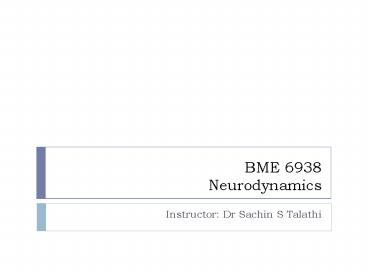BME 6938 Neurodynamics - PowerPoint PPT Presentation
1 / 22
Title:
BME 6938 Neurodynamics
Description:
... Ralls Model-Equivalent cylinder Basic Idea: Impedence matching Assumptions: The membrane properties are identical for soma and dendritic branches. 2. – PowerPoint PPT presentation
Number of Views:95
Avg rating:3.0/5.0
Title: BME 6938 Neurodynamics
1
BME 6938Neurodynamics
- Instructor Dr Sachin S Talathi
2
The cell membrane-equivalent circuit
Pore Resistance
The bilipid layer Capacitance
3
The First ODE-For XPPAuto
- Passive Membrane with time dependent input
current - Look up nice tutorial on using xppauto on bards
webpage at http//www.math.pitt.edu/bard/bardware
/tut/start.html
4
XPPAuto ODE File
passive membrane with step function current
passive.ode parameter R_M10000, C_m1, I_02,
E-70 parameter t_on5, t_off10,Vm0 dV/dt
(1000(Vm-V)/R_M I_0f(t))/C_M V(0)0
define a pulse function f(t)heav(t_off-t)heav(t
-t_on) track the current aux ibarf(t)I_0
done
Comment
Define Parameters
The ODE
Initial Conditions
The Function
Aux File
End of File
5
The Cable Theory for Passive Cell
Use the mathematical frame work of linear cable
theory and the elec. circuit representation of
neuronal cell membrane to understand how membrane
potential is affected in function of neuronal
cell geometry. Important to understand concepts
like synaptic integration
Assumptions Membrane parameters are linear and
independent of mem. potential (passive) current
entering the cable flows linearly (homogeneous)
resistance of extracellular medium is zero (cell
immersed in homogeneous isopotential medium, the
reference)
6
Kirchoffs Current law applied to cable
Cm Membrane Capacitance (F) Rm Membrane
Resistance (Ohm) Ra Axial Resistance (Ohm) Iext
External current (Amp)
7
The Cable Equation
CM Specific Capacitance (F/cm2) RM Specific
Resistance (Ohm-cm2) RA Specific Axial
Resistance (Ohm-cm) iext Current density
(Amp/cm2)
8
The Cable Equation Rescaling Variables
9
Recap
The Cable Equation
IM
IL
d
IM Membrane Current (Amp/cm2) CM Specific
Capacitance (F/cm2) RM Specific Resistance
(Ohm-cm2) RA Specific Axial Resistance (Ohm-cm)
Space Constant
Time Constant
The Cable Equation Steady State
10
Longitudinal Current Input Resistance
RL Cytoplasmic Resistance per unit length
(Ohm/cm)
11
The Cable Equation Steady State
Greens Function G(X) Solution to Steady State
Cable Equation for
with boundary conditions
(Infinite cable)
Solution to Steady State Cable Equation
12
Steady State Boundary Conditions
Boundary Condition
Cable Type
Schematic Diagram
- Semi-Infinite Cable
- Finite Cable Sealed End
- (closed circuit)
- Finite Cable Open End
- (open circuit)
- Finite Cable Clamped End
13
Semi-Infinite Cable Constant Current
I0
14
Finite Cable Constant Current
Length of Cable l Dimensionless
Length General Solution
Conductance of terminal end
Conductance of semi-infinite cable
15
Finite Cable Sealed End
I0
L
16
Finite Cable Open End
I0
L
17
Finite Cable Clamped End
I0
18
Steady State Solution
Boundary Condition
Cable Type
Solution
- Semi-Infinite Cable
- Finite Cable Sealed End
- Finite Cable Open End
- Finite Cable Clamped End
19
Steady State Solution
20
Cable Equation Transient Solution
Greens Function G(X,T) for infinite cable
solution of above equation for With initial
condition and Boundary condition
General Solution to Cable Equation
Hint Use the formula
21
Ralls Model-Equivalent cylinder
- Basic Idea Impedence matching
- Assumptions
- The membrane properties are identical for soma
and dendritic - branches.
- 2. Membrane properties are uniform and voltage
independent - 3. All dendritic branches terminate at the same
electrotonic length (and the tip of dendrite ends
are sealed)
Class assignment Please read sections 4.5.1.3
and 4.5.2 on your own.
22
Synaptic Integration
Model for current injection into neuron through
synapse-alpha function
Use XPP AUTO to answer following Questions
(Cable.ode) 1. Sketch the potential at the soma
for the synaptic input at compartments 0, 5, 10,
and 20. 1a.How do the peak amplitudes depend on
distance? 1b. How about the time to peak?
1c.Does the peak appear to decay slower or
faster for more distant inputs? 1d. How does the
potential scale across various compartments For
synaptic input at different locations on the
cable































